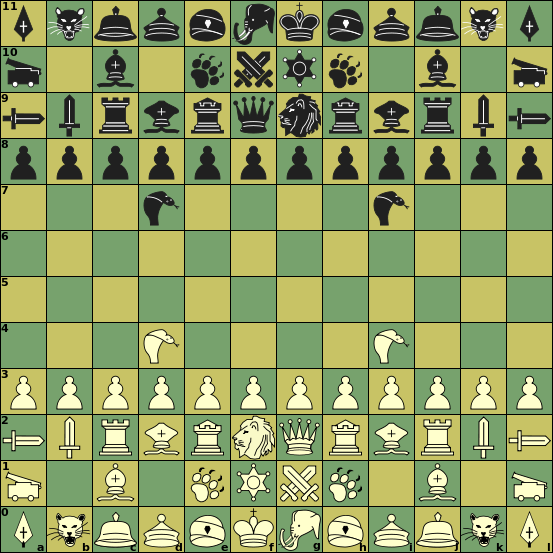Both setups seem pretty good, I'll have to try them both out. I do have one question about the trading lions rules.
It's not legal to trade lions, but you can "hang" your own lion by mistake? Is that correct?
As far as the setup goes, replacing the knight looks more elegant, but both seem like good setups. I would suggest a possible third starting position as well, same as the first except the knight goes on a3 and pawn on a2. All 3 I think have advantages/disadvantages.








I designed a new 'modest' Chess variant, which adds a single new piece to orthodox Chess. This piece, called 'Lion', is the dominant piece of Chu Shogi. It is an extremely interesting piece, and I felt said that it could only be enjoyed in Chu Shogi, with its horrendous complexity of 36 piece types. Hence I came up with this variant.
The Lion moves as a King, but then twice per turn! It can change direction between steps, and the first step can be taken as a jump, if you so please, so the Lion cannot be blocked. The second step is optional, so it can also move as a normal King. The interesting thing is that a Lion can still make its second step if the first step was a capture, so it can capture upto two pieces per turn. It is also capable of 'hit-and-run' capture, withdrawing to a safe square (possibly the square it came from) after the capture, leaving any protectors of its victim staring at thin air.
This makes a Lion a very powerful piece. It is true that it does not have all the moves of a QN compound (the 'Amazon'), but its double-capture abilities make it way stronger in practice. (About 15, where Q=9 and A=12.)
In variants of this type, there always is the danger that the 'exo-piece' is quickly traded, leaving a game of normal Chess with a wrecked opening. To prevent that, there are rules that forbid such trades (also borrowed from Chu Shogi): A Lion is not allowed to capture another Lion from a distance when pseudo-legal recapture of it is possible. (Another way of saying this is that the Lion that made such a capture temporarily becomes a King during the opponent's following half-move.) Capturing an adjacent Lion with a Lion is always allowed (as normally you would use hit-and-run anyway). Indirect trading is also forbidden: after your Lion is captured by a non-Lion, the opponent's Lion may not be captured on the next half-move. (It becomes 'iron'.)
These rules guarantee the Lions will typically remain in play for most of the game, despite the fact that they are so powerful they will be 'banging heads' very quickly. (Subjecting Queens to similar rules in orthodox Chess would also be an interesting experiment!)
Pawns promote as in FIDE, i.e. they cannot promote to Lion. The initial setup I envisaged was this:
This leaves the strongest pieces on the board (to provide some counterweight to the Lions, which otherwise would become all-powerful). Over the board the game could be played by wrapping a rubber band around one of the Knights, or set in on a checkers chip pedestal, to turn it into a Lion. An alternative setup keeps both Knights on the board, and just adds the Lion as a 17th piece. (You could use the bare checkers chip, or an inverted Rook of another set as Lion.)
(Which setup would you think best?)